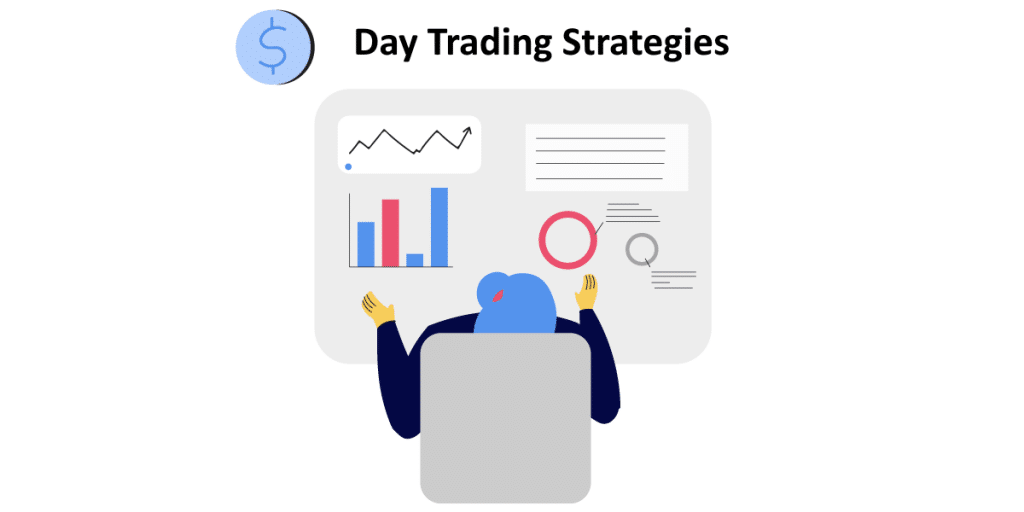If you’ve stumbled across this article, chances are you’ve heard of day trading and are interested in checking it out or you’re an experienced trader wanting to branch out.
Whatever the reason, you’ve come to the right place. In this article, we will explain day trading and the associated pros and cons. We will also be going over some common day trading strategies.
A word of warning before we continue, if you’re a beginner we don’t recommend you start out with day trading. However, if you’re really interested in learning more, we recommend you do extensive research on the topic. You can also check out our guide on day trading apps for beginners.
If you decide to go with a day trading broker, there are account fees and account minimums to consider.
What is Day Trading?
In simple terms, day trading is a high-volume trading method that involves buying and selling a financial instrument on the same day or multiple times in a day.
Day trading is a risky business and it is important to have a well-thought-out trading strategy.
Trading strategies are built on detailed technical analysis, and use charts, indicators, and patterns to track price fluctuations.
This trading method is ideal if you’re looking to profit off of small price movements in the financial market.
If you’re interested in day trading, choose a broker with the best accommodations for day trading practices. These can include discounts, lower fees, and great trading tools.
For day trading, we recommend you check out Fidelity and Interactive Brokers. Both offer great trading platforms and short features like advanced charting tools and real-time streaming quotes.
Things to keep in mind before day trading
- Day trading can be profitable but this depends on how serious you are and how well you do your research.
- Day trading should be treated as a job and is not ideal if you’re a casual investor. It requires diligence and focus.
- Day trading can be quite time-consuming and requires a lot of know-how.
Day Trading Tips and Tricks
Starting in investments and trading can be overwhelming. There are a plethora of methods and financial instruments, and trading strategies that it can be hard to know where to start.
If you’re an experienced trader looking to branch out into day trading, here are a few of our favorite tips and tricks to help you on your journey.
Save up!
Starting any type of investment or trade requires a bit of cash. Before jumping in, decide how much you’re willing to risk on investments and trade.
We suggest you save up a bit of capital before rushing into anything.
Baby steps
If you’re starting without any experience in day trading then start small. A great way of getting a feel for day trading is to start on one or two small stocks. As you become more adept at tracking and finding opportunities, you can expand your trading.
Avoid Penny Stocks!
Rushing toward the lowest stock prices can be tempting but we don’t recommend day trading in penny stocks. Penny stocks on their own are risky and when combined with the risks associated with day trading, they can become dangerous.
Time your Trades
Before jumping in and trading at the crack of dawn, keep an eye on price fluctuations throughout the day. Tracking price fluctuations is a great way to decide which time of day is the best for you to execute trades.
It is better to wait and check the market before jumping in.
Elements that every day trading strategy needs
Whether you choose to go for an automated day trading strategy or are looking for more advanced trading techniques, the strategy you choose should include these key components:
Liquidity
The liquidity of a financial asset allows traders to quickly enter and exit trades at an attractive and stable price point. Examples of great assets include liquid commodities like oil or gold.
Volatility
The volatility is a measurement of a trader’s potential profit/price range. This is the range that the trader day trades in.
An increase in volatility often increases the profit or loss that traders can make.
An example of a financial asset that is known for its high volatility is cryptocurrency.
Volume
The trading volume is an indication of how often a stock/financial asset is bought and sold within a period. This is also known as the ‘average daily trading volume’.
A high trading volume is indicative of a popular financial asset that has generated a lot of interest. This can be because the price of the asset is expected to either spike up or dropdown.
Day Trading Strategies Explained
So, you’ve done your research, familiarized yourself with the techniques, and have set your investment and trading goals. But, how to reach those goals?
Here are a few basic day trading strategies that could help.
Scalping
Scalping is a popular day trading strategy. It involves a speculator who takes advantage of small price gaps that are created in bid-ask spreads. This entails quickly entering and exiting positions, typically within minutes or seconds.
Scalping is prevalent in forex markets and it aims to profit from minute price changes.
What makes scalping profitable is the volume and quality of the executed trades. Traders aim to sell as soon as an asset becomes profitable.
A word of warning, scalping is fast-paced and intense.
Contrarian Investing
Contrarian investing is a strategy that assumes that the rise in prices will reverse and drop. Contrarian investing is also known as reversal trading, trend trading, or pull-back trading.
When using this method, traders will ‘trade against the trend’. This entails buying during a fall or short-sells during a rise with the expectation that the trend will shift.
Contrarian investing is particularly risky because it goes against the grain. Traders who use this method have to be confident that they can accurately predict market trends and the strength of these trends.
Momentum
Momentum day trading, also known as trading the news, is a strategy that entails buying and selling according to the news. For example, if the news is good, traders will buy and if the news is bad, traders will sell. This strategy increases volatility which can lead to greater profits and losses.
This method of day trading is popular among beginners since it relies on news sources for its decision-making.
A key aspect of this method is that it requires traders to keep up with the latest news and earnings announcements. This can be quite time-consuming.
Following the Trend
This is the simplest day trading strategy. As the name suggests, traders who use this method will buy when prices are increasing and short-sell when price points are dropping.
This method assumes that prices have risen and fallen at a steady rate and will continue to follow this trend.
In Summary
Day trading involves buying and selling financial assets within a day or numerous times a day. This kind of trading takes advantage of small price fluctuations and aims to make a profit from them.
Day trading is a difficult business and it is not something that can easily be mastered. It demands time, discipline, and a certain level of know-how. We don’t recommend this type of trading for beginners.
However, if you’re confident in your abilities, day trading can be a lucrative means of making a profit.




